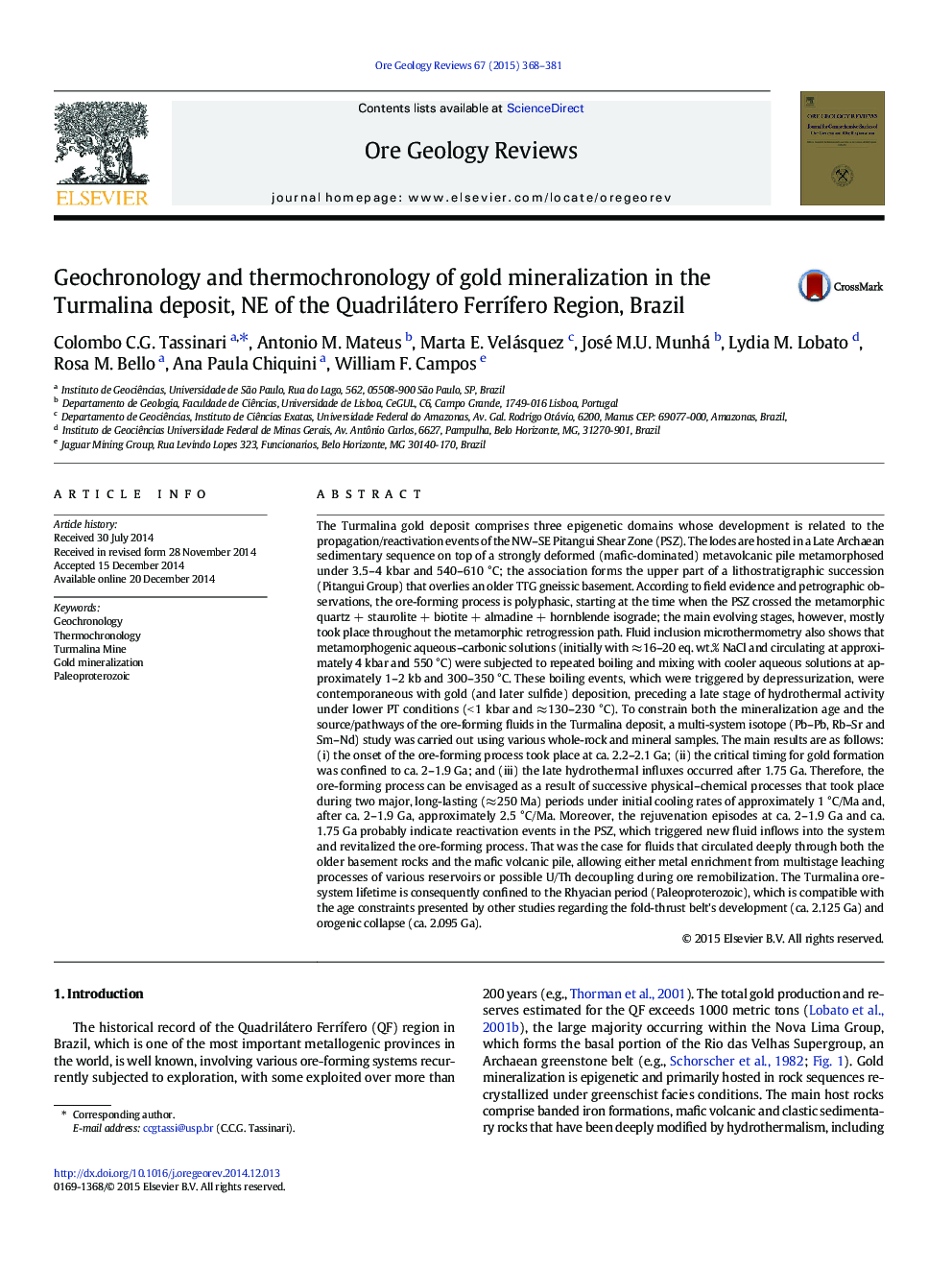| کد مقاله | کد نشریه | سال انتشار | مقاله انگلیسی | نسخه تمام متن |
|---|---|---|---|---|
| 6435900 | 1637237 | 2015 | 14 صفحه PDF | دانلود رایگان |

- The host rocks record effects of metamorphism under 3.5-4 kbar and 540-610 °C.
- The aqueous-carbonic fluid suffered boiling and mixing with cooler fluids at 1-2 kb and 300-350 °C.
- The onset of the ore-forming process took place at ca. 2.1-2.2Â Ga.
- Timing of Au formation was at 1.9-2Â Ga and late hydrothermal influxes happened after 1.75Â Ga.
- The ore-forming took place in two periods, with cooling rates of 1 °C/Ma and 2.5 °C/Ma.
The Turmalina gold deposit comprises three epigenetic domains whose development is related to the propagation/reactivation events of the NW-SE Pitangui Shear Zone (PSZ). The lodes are hosted in a Late Archaean sedimentary sequence on top of a strongly deformed (mafic-dominated) metavolcanic pile metamorphosed under 3.5-4 kbar and 540-610 °C; the association forms the upper part of a lithostratigraphic succession (Pitangui Group) that overlies an older TTG gneissic basement. According to field evidence and petrographic observations, the ore-forming process is polyphasic, starting at the time when the PSZ crossed the metamorphic quartz + staurolite + biotite + almadine + hornblende isograde; the main evolving stages, however, mostly took place throughout the metamorphic retrogression path. Fluid inclusion microthermometry also shows that metamorphogenic aqueous-carbonic solutions (initially with â 16-20 eq. wt.% NaCl and circulating at approximately 4 kbar and 550 °C) were subjected to repeated boiling and mixing with cooler aqueous solutions at approximately 1-2 kb and 300-350 °C. These boiling events, which were triggered by depressurization, were contemporaneous with gold (and later sulfide) deposition, preceding a late stage of hydrothermal activity under lower PT conditions (< 1 kbar and â 130-230 °C). To constrain both the mineralization age and the source/pathways of the ore-forming fluids in the Turmalina deposit, a multi-system isotope (Pb-Pb, Rb-Sr and Sm-Nd) study was carried out using various whole-rock and mineral samples. The main results are as follows: (i) the onset of the ore-forming process took place at ca. 2.2-2.1 Ga; (ii) the critical timing for gold formation was confined to ca. 2-1.9 Ga; and (iii) the late hydrothermal influxes occurred after 1.75 Ga. Therefore, the ore-forming process can be envisaged as a result of successive physical-chemical processes that took place during two major, long-lasting (â 250 Ma) periods under initial cooling rates of approximately 1 °C/Ma and, after ca. 2-1.9 Ga, approximately 2.5 °C/Ma. Moreover, the rejuvenation episodes at ca. 2-1.9 Ga and ca. 1.75 Ga probably indicate reactivation events in the PSZ, which triggered new fluid inflows into the system and revitalized the ore-forming process. That was the case for fluids that circulated deeply through both the older basement rocks and the mafic volcanic pile, allowing either metal enrichment from multistage leaching processes of various reservoirs or possible U/Th decoupling during ore remobilization. The Turmalina ore-system lifetime is consequently confined to the Rhyacian period (Paleoproterozoic), which is compatible with the age constraints presented by other studies regarding the fold-thrust belt's development (ca. 2.125 Ga) and orogenic collapse (ca. 2.095 Ga).
Journal: Ore Geology Reviews - Volume 67, June 2015, Pages 368-381